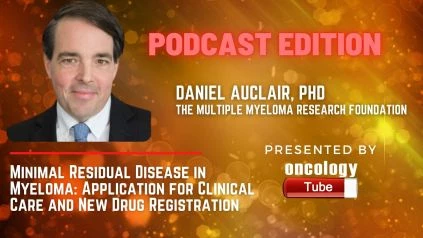Daniel Auclair, Ph.D., Chief Scientific Officer, The Multiple Myeloma Research Foundation speaks about Minimal Residual Disease in Myeloma: Application for Clinical Care and New Drug Registration.
Link to Article:
https://pubmed.ncbi.nlm.nih.gov/34321279/
Summary –
The discovery of new medicines has changed the therapeutic paradigm for multiple myeloma (MM), with MRD negative now possible throughout the whole disease spectrum. Real-time clinical tools for the sensitive identification and monitoring of MRD in MM patients have been given by bone marrow-based technologies to measure MRD, including methods employing next-generation flow and next-generation sequencing. Complementary liquid biopsy-based assays are rapidly evolving, with some, such as mass spectrometry techniques, nearing clinical usage, while others based on nucleic acid-based technologies are still in development and will be critical in furthering our understanding of MRD biology. Multiple retrospective individual patient and clinical trial level meta-analyses have previously demonstrated and will continue to examine the potential of MRD as a proxy for patient outcome on the regulatory front. Given this progress, it’s not surprising that a growing number of clinicians are considering using MRD to guide real-world clinical care for patients ranging from smoldering myeloma to relapsed refractory MM, with each disease setting posing unique challenges and questions that will require clinical trials to answer. The rate of progress in MM targeted and immunological therapy is unparalleled, and novel MRD-driven biomarker techniques are critical to speeding up creative clinical studies that lead to regulatory approval of novel medicines and ongoing improvements in patient outcomes.

